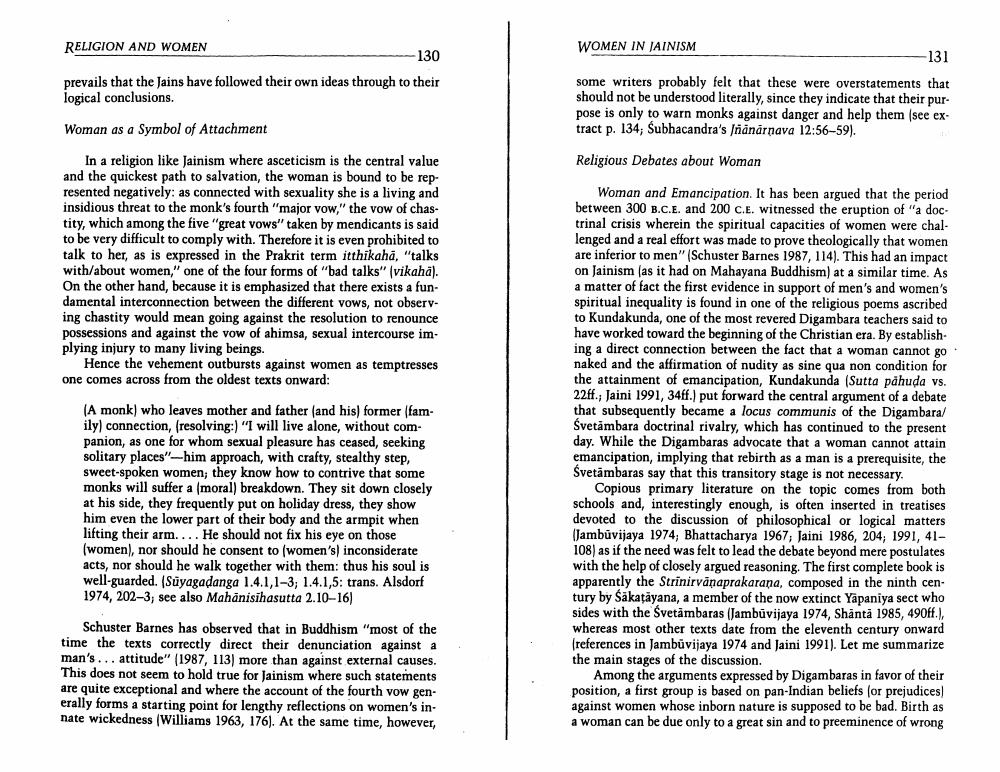________________
RELIGION AND WOMEN
130 prevails that the Jains have followed their own ideas through to their logical conclusions.
WOMEN IN JAINISM
-131 some writers probably felt that these were overstatements that should not be understood literally, since they indicate that their purpose is only to warn monks against danger and help them see extract p. 134, Subhacandra's nánarnava 12:56-59).
Woman as a Symbol of Attachment
Religious Debates about Woman
In a religion like Jainism where asceticism is the central value and the quickest path to salvation, the woman is bound to be represented negatively: as connected with sexuality she is a living and insidious threat to the monk's fourth "major vow," the vow of chastity, which among the five "great vows" taken by mendicants is said to be very difficult to comply with. Therefore it is even prohibited to talk to her, as is expressed in the Prakrit term itthikahā, "talks with/about women," one of the four forms of "bad talks" (vikaha). On the other hand, because it is emphasized that there exists a fundamental interconnection between the different vows, not observing chastity would mean going against the resolution to renounce possessions and against the vow of ahimsa, sexual intercourse im. plying injury to many living beings.
Hence the vehement outbursts against women as temptresses one comes across from the oldest texts onward:
(A monk) who leaves mother and father and his) former (family) connection, (resolving:) "I will live alone, without companion, as one for whom sexual pleasure has ceased, seeking solitary places"-him approach, with crafty, stealthy step, sweet-spoken women; they know how to contrive that some monks will suffer a (moral) breakdown. They sit down closely at his side, they frequently put on holiday dress, they show him even the lower part of their body and the armpit when lifting their arm. ... He should not fix his eye on those (women), nor should he consent to women's) inconsiderate acts, nor should he walk together with them: thus his soul is well-guarded. (Suyagadanga 1.4.1,1-3; 1.4.1,5: trans. Alsdorf 1974, 202-3, see also Mahānisihasutta 2.10-16)
Woman and Emancipation. It has been argued that the period between 300 B.C.E. and 200 C.E. witnessed the eruption of "a doc. trinal crisis wherein the spiritual capacities of women were challenged and a real effort was made to prove theologically that women are inferior to men" (Schuster Barnes 1987, 114). This had an impact on Jainism (as it had on Mahayana Buddhism) at a similar time. As a matter of fact the first evidence in support of men's and women's spiritual inequality is found in one of the religious poems ascribed to Kundakunda, one of the most revered Digambara teachers said to have worked toward the beginning of the Christian era. By establishing a direct connection between the fact that a woman cannot go naked and the affirmation of nudity as sine qua non condition for the attainment of emancipation, Kundakunda (Sutta pähuda vs. 22ff., Jaini 1991, 34ff.) put forward the central argument of a debate that subsequently became a locus communis of the Digambara/ Svetambara doctrinal rivalry, which has continued to the present day. While the Digambaras advocate that a woman cannot attain emancipation, implying that rebirth as a man is a prerequisite, the Svetämbaras say that this transitory stage is not necessary.
Copious primary literature on the topic comes from both schools and, interestingly enough, is often inserted in treatises devoted to the discussion of philosophical or logical matters (Jambūvijaya 1974, Bhattacharya 1967, Jaini 1986, 204, 1991, 41108) as if the need was felt to lead the debate beyond mere postulates with the help of closely argued reasoning. The first complete book is apparently the Strinirvānaprakarana, composed in the ninth century by Sakatāyana, a member of the now extinct Yapaniya sect who sides with the Svetambaras (Jambūvijaya 1974, Shanta 1985, 490ff.), whereas most other texts date from the eleventh century onward (references in Jambúvijaya 1974 and Jaini 1991). Let me summarize the main stages of the discussion.
Among the arguments expressed by Digambaras in favor of their position, a first group is based on pan-Indian beliefs (or prejudices) against women whose inborn nature is supposed to be bad. Birth as a woman can be due only to a great sin and to preeminence of wrong
Schuster Barnes has observed that in Buddhism "most of the time the texts correctly direct their denunciation against a man's... attitude" (1987, 113) more than against external causes. This does not seem to hold true for Jainism where such statements are quite exceptional and where the account of the fourth vow generally forms a starting point for lengthy reflections on women's innate wickedness (Williams 1963, 176). At the same time, however,




